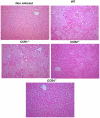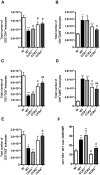Role of the chemokine receptors CCR1, CCR2 and CCR4 in the pathogenesis of experimental dengue infection in mice
- PMID: 21206747
- PMCID: PMC3012079
- DOI: 10.1371/journal.pone.0015680
Role of the chemokine receptors CCR1, CCR2 and CCR4 in the pathogenesis of experimental dengue infection in mice
Abstract
Dengue virus (DENV), a mosquito-borne flavivirus, is a public health problem in many tropical countries. Recent clinical data have shown an association between levels of different chemokines in plasma and severity of dengue. We evaluated the role of CC chemokine receptors CCR1, CCR2 and CCR4 in an experimental model of DENV-2 infection in mice. Infection of mice induced evident clinical disease and tissue damage, including thrombocytopenia, hemoconcentration, lymphopenia, increased levels of transaminases and pro-inflammatory cytokines, and lethality in WT mice. Importantly, infected WT mice presented increased levels of chemokines CCL2/JE, CCL3/MIP-1α and CCL5/RANTES in spleen and liver. CCR1⁻/⁻ mice had a mild phenotype with disease presentation and lethality similar to those of WT mice. In CCR2⁻/⁻ mice, lethality, liver damage, levels of IL-6 and IFN-γ, and leukocyte activation were attenuated. However, thrombocytopenia, hemoconcentration and systemic TNF-α levels were similar to infected WT mice. Infection enhanced levels of CCL17/TARC, a CCR4 ligand. In CCR4⁻/⁻ mice, lethality, tissue injury and systemic inflammation were markedly decreased. Despite differences in disease presentation in CCR-deficient mice, there was no significant difference in viral load. In conclusion, activation of chemokine receptors has discrete roles in the pathogenesis of dengue infection. These studies suggest that the chemokine storm that follows severe primary dengue infection associates mostly to development of disease rather than protection.
Conflict of interest statement
Figures








Similar articles
-
Role of CC chemokine receptor 1 and two of its ligands in human dengue infection. Three approaches under the Cuban situation.Microbes Infect. 2014 Jan;16(1):40-50. doi: 10.1016/j.micinf.2013.10.011. Epub 2013 Oct 22. Microbes Infect. 2014. PMID: 24157267
-
CCR2+ and CCR5+ CD8+ T cells increase during viral infection and migrate to sites of infection.Eur J Immunol. 2000 Jul;30(7):1797-806. doi: 10.1002/1521-4141(200007)30:7<1797::AID-IMMU1797>3.0.CO;2-B. Eur J Immunol. 2000. PMID: 10940868
-
MIP-1alpha[CCL3] acting on the CCR1 receptor mediates neutrophil migration in immune inflammation via sequential release of TNF-alpha and LTB4.J Leukoc Biol. 2005 Jul;78(1):167-77. doi: 10.1189/jlb.0404237. Epub 2005 Apr 14. J Leukoc Biol. 2005. PMID: 15831559
-
CCR1 and CCR2 antagonists.Curr Top Med Chem. 2014;14(13):1539-52. doi: 10.2174/1568026614666140827144115. Curr Top Med Chem. 2014. PMID: 25159163 Review.
-
CC Chemokine Family Members' Modulation as a Novel Approach for Treating Central Nervous System and Peripheral Nervous System Injury-A Review of Clinical and Experimental Findings.Int J Mol Sci. 2024 Mar 28;25(7):3788. doi: 10.3390/ijms25073788. Int J Mol Sci. 2024. PMID: 38612597 Free PMC article. Review.
Cited by
-
The pathology of severe dengue in multiple organs of human fatal cases: histopathology, ultrastructure and virus replication.PLoS One. 2014 Apr 15;9(4):e83386. doi: 10.1371/journal.pone.0083386. eCollection 2014. PLoS One. 2014. PMID: 24736395 Free PMC article.
-
SB203580 Modulates p38 MAPK Signaling and Dengue Virus-Induced Liver Injury by Reducing MAPKAPK2, HSP27, and ATF2 Phosphorylation.PLoS One. 2016 Feb 22;11(2):e0149486. doi: 10.1371/journal.pone.0149486. eCollection 2016. PLoS One. 2016. PMID: 26901653 Free PMC article.
-
Dengue virus requires the CC-chemokine receptor CCR5 for replication and infection development.Immunology. 2015 Aug;145(4):583-96. doi: 10.1111/imm.12476. Epub 2015 Jun 1. Immunology. 2015. PMID: 25939314 Free PMC article.
-
Serum Cytokine Profiles in Patients with Dengue Fever at the Acute Infection Phase.Dis Markers. 2018 Jan 30;2018:8403937. doi: 10.1155/2018/8403937. eCollection 2018. Dis Markers. 2018. PMID: 29651328 Free PMC article.
-
A model of DENV-3 infection that recapitulates severe disease and highlights the importance of IFN-γ in host resistance to infection.PLoS Negl Trop Dis. 2012;6(5):e1663. doi: 10.1371/journal.pntd.0001663. Epub 2012 May 29. PLoS Negl Trop Dis. 2012. PMID: 22666512 Free PMC article.
References
-
- Guzman MG, Kouri G. Dengue: an update. Lancet Infect Dis. 2002;2:33–42. - PubMed
-
- Mackenzie JS, Gubler DJ, Petersen LR. Emerging flaviviruses: the spread and resurgence of Japanese encephalitis, West Nile and dengue viruses. Nat Med. 2004;10:S98–109. - PubMed
-
- Kalayanarooj S, Vaughn DW, Nimmannitya S, Green S, Suntayakorn S, et al. Early clinical and laboratory indicators of acute dengue illness. J Infect Dis. 1997;176:313–321. - PubMed
-
- Deen JL, Harris E, Wills B, Balmaseda A, Hammond SN, et al. The WHO dengue classification and case definitions: time for a reassessment. Lancet. 2006;368:170–173. - PubMed
Publication types
MeSH terms
Substances
LinkOut - more resources
Full Text Sources
Other Literature Sources
Medical
Molecular Biology Databases

